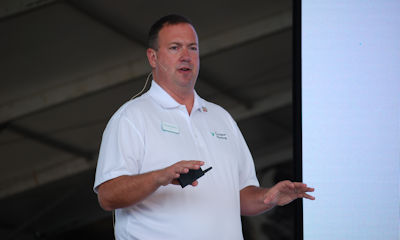
Residue management is not getting any easier. In fact, Tom Brubaker, region manager for Precision Planting, says stronger stalks, higher plant populations and cover crops are leaving even more residue in fields. “We’re all chasing yield, we’re all chasing more resilient plants, more resilient hybrids,” Brubaker says. “That means they’re stronger. There’s going to be more residue left in your fields.”
Corn-on-corn fields are particularly challenging.

“Manage your residue, don’t let it manage you,” says Tom Brubaker, region manager for Precision Planting.
So why does residue matter? Brubaker says residue left behind may impact germination, and ultimately yield. He references a CropTech study that found late emergence from excess residue could impact yield by almost five bushels an acre.
Brubaker says residue impacts emergence in four different ways:
1) Moisture thief
Residue acts like sponge and “wicks moisture” away from the seed. Inadequate moisture leads to late emergence.
2) Insulation situation
The residue acts like an insulator, leaving rows with heavy residue 10 to 20 degrees colder than clean rows - not good when seeds need heat to germinate. “If you have inconsistency in your soil temp, you’ll have inconsistency in your emergence,” Brubaker says. “You’ll have stunted, late emergers and that’s not good for your yield.”
3) Toxic environment
Plant health and uniformity is impacted right from the start. Brubaker explains that corn plants get 80% of their nutrient needs from the seed and seminal root up to the V2 growth stage. Too much composting residue may release toxins, blocking nutrient uptake and introducing seedling blight. “That’s something nobody wants,” Brubaker adds.
4) Nitrogen (N) and Phosphorus (P) stealer
The same “composting activity” in excess residue may trap N and P, inhibiting the plants’ ability to take up those key nutrients.
How can farmers manage residue? Row cleaners need to be constantly cleaned and maintained during planting to ensure they’re doing their job, Brubaker says. “If they’re set too light, you can introduce those toxins and impact compaction,” he notes. “Too deep and you’re digging trenches.”
Precision Planting has developed Clean Sweep, a row cleaner you can adjust from the cab.
The other option? Jumping out of the cab to clean and manually adjusting row cleaners. Not something most farmers want to deal with during planting season, but either way, Brubaker says the results will pay off in even emergence and yield.
About the Author(s)
You May Also Like




